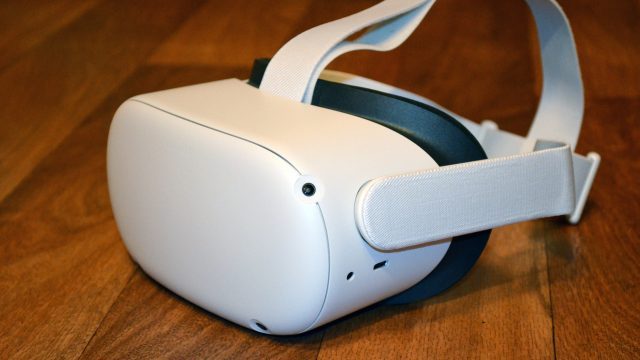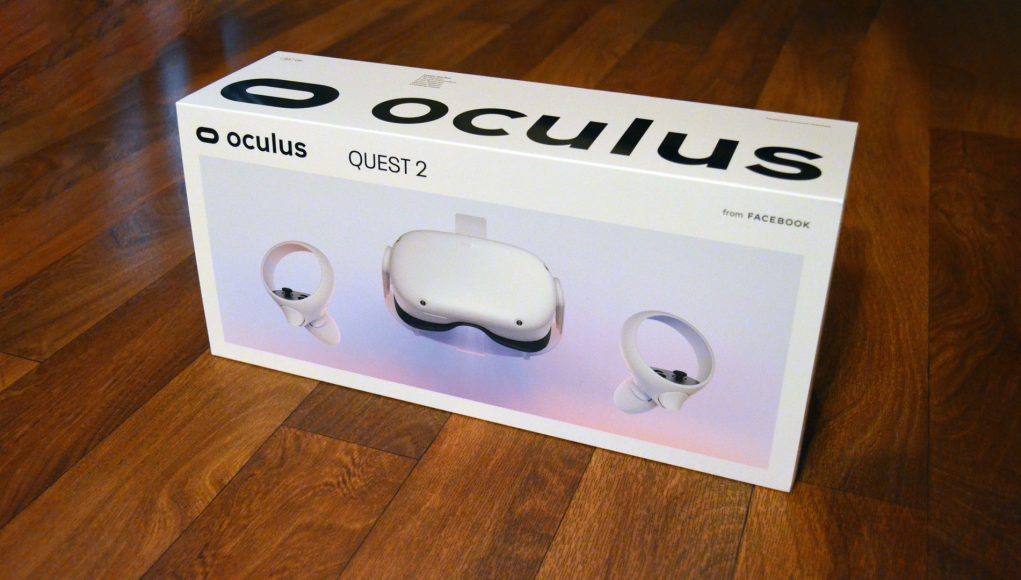Tracking

Just like its predecessor, Quest 2 uses four cameras for inside-out tracking, controller tracking, and hand-tracking.
Oculus tells us that Quest 2 is using the same IR sensors (same resolution, same refresh rate, etc) but they have “slightly” better low-light performance.
As such, it’s not surprising that Quest 2 seems to track just as well as the original Quest (which has improved over time). That means it has leading inside-out tracking in a VR headset in both performance and controller tracking coverage.
It’s not the most accurate tracking system out there overall—and it still has some blind spots based on what the cameras can see—but it’s more than sufficient for the vast majority of games.
And while inside-out tracking can often be prone to varying quality depending upon environmental conditions (light, moving objects, etc), we’ve found Quest 2’s tracking to continue to be remarkably robust even in especially challenging scenarios like with a ceiling fan, holiday lights, and swinging blinds.
Across all of our testing, Quest 2’s head and controller-tracking feels like something you just don’t really need to think about.
Controller-less hand-tracking is also available on Quest 2, but it isn’t as responsive or accurate as controller-tracking. It seems to work just as well as hand-tracking does on the original Quest, though Oculus says they expect that might be able to eek some more improvements out over time thanks to the increased power of Quest 2.
Experience

The Quest 2’s day-one experience is the pinnacle of what Oculus has been honing over more than a year on the original Quest. With pass-through boundary setup and a near instant wake-from-sleep, it’s far and away the easiest way to jump into room-scale VR.
Out of Beta
Over the course of Quest’s lifetime, Oculus has significantly revamped and streamlined its software experience. Now that Facebook is more deeply woven into the core Quest operating system, you’re required to log into Quest 2 with a Facebook account.
The system interface is far snappier than it was at the outset. The system menu now appears inside of games instead of taking you out of them. There’s a host of new ‘home’ environments to choose from, including being able to set the pass-through view as your ‘background’. That last part is really nice for two reasons: 1) you can always see your controllers to pick them up rather than blindly feeling around for them, and 2) the transition into and out of VR is much less jarring since you still have a view of the real world around you, even when you first put the headset on.
One of the biggest improvements that Quest 2 gets out of the box (original Quest had to wait for) is hand-tracking. While there’s still no ‘must-have’ hand-tracking games out there, it’s really nice just to be able to control the entire Quest 2 menu system without needing to pick up your controllers every time. Sometimes you just want to pop in to check something quickly; being able to do so without picking up the controllers just makes the headset that much more accessible.
While menus are definitely more responsive than they once were, I still find the Quest 2 (and Quest) interface to be poorly designed. Don’t get me wrong, it’s taken a strong step forward since the launch of the original Quest, but there’s still some serious room for improvement in layout, hierarchy, and affordances.
As an apparent (and convenient) crutch, Quest 2 now has Voice Commands out of the gate which are really quite handy. When you double-tap the Oculus button you’ll be prompted for a command. The headset can understand many basic actions like “search for Beat Saber” or “launch Phantom: Covert Ops.” It’ll also tell you what time it is, how much battery life you have left, or search Google for you via the Oculus Browser.
Speaking of the Browser, it’s quite nice to use these days, which is thanks to feature improvements and to Quest 2’s higher resolution display. With its increased resolution, the browser lets you see more of a website’s real estate. Using controllers (or especially hands) to navigate the browser is still a bit painfully slow (and there’s no basic copy+paste or ‘Save Link As’ functionality), but you can at least now use voice input in the keyboard to dictate a Google search more quickly than typing it.
A Trove of VR Classics
Curiously, Quest 2 content lineup is looking a lot like what happened with Quest. The headset originally launched with essentially no ‘killer app’ to launch alongside it; most of the best content were games ported from other platforms.
Quest 2 is in the same boat. Not only have we not been able to see any games at 90Hz yet, but there aren’t any we’re particularly excited about that will be available at launch.
That said, if Quest 2 is your first VR headset, there’s a solid number of good games to enjoy. The Quest library recently eclipsed 200 titles, and you’ll be able to play a bunch of VR favorites on day one—like Beat Saber, Moss, I Expect You to Die!, Superhot VR, Pistol Whip, Job Simulator, Vader Immortal, Onward, and more. But for anyone who isn’t new to VR, you’ve likely played these games before.
To be fair, Oculus has confirmed some exciting content on the horizon, but most of it won’t be available until sometime after Quest 2 launches.
Some of the games we are looking forward to playing on Quest 2 are the upcoming Assassin’s Creed and Splinter Cell VR games, The Climb 2, Jurassic World Aftermath, Myst, Pistol Whip’s ‘2089’ update, and Warhammer 40,000: Battle Sister. But alas, none will be available on launch day.
Oculus Link
With Oculus Link you can plug your Quest 2 into a VR ready PC and use it just like a Rift. That means you can play games from the Oculus PC library or play from other VR libraries like SteamVR. That makes Quest 2 a very versatile headset, but unfortunately we haven’t seen the full potential of Link on Quest 2 just yet.
The USB cable included with Quest 2 isn’t really long enough for Link, so you’ll need to buy a separate one.
I would say it’s surprising that Oculus hasn’t optimized Link for Quest 2 yet, but then again its upcoming discontinuation of the entire Rift product line shows they don’t have much interest in PC-based VR any longer.
Right now the Link experience isn’t much different than what you’d get with the original Quest. At present, Quest 2 with Link is still running at 72Hz rather than 90Hz, and its video encoding hasn’t been optimized for Quest 2’s resolution. Oculus says it plans to make those updates “soon” after the launch of the headset.
Our experience with Link has been fine, but if Oculus is now pitching Quest as both its standalone headset and its PC VR headset, it’s going to have to do more than fine with Link if it has any interest in serving the enthusiast crowd.
Summary
Although it’s going to take more time until its true potential is fully unlocked through various post-launch software updates—and there’s no escaping Facebook’s tendrils—Quest 2 is the best standalone headset you can buy, and amazingly the most affordable in its class at $300. You’ll need to tack on another $50 for the Elite Strap to get the best version of Quest 2, but otherwise it’s an improvement over the original Quest in almost every way: more power, higher resolution, better refresh rate, improved controllers. It doesn’t do anything new—and we’ll be waiting a while for content that truly makes it shine—but it can clearly be called the best version of Quest yet.
– – — – –
Got more questions? We’ve got more answers! Drop us a comment below and tells us what you want to know about Quest 2.
Disclosure: Oculus provided Road to VR with a Quest 2 headset.







